Has your heart ever leapt at the sight of an urban apartment building? I suspect not. Mine practically jumped out of my chest when I clapped eyes on the one I am going to tell you about. I knew immediately I had hit the jackpot: a geometric goldmine; a technicolour temple; an abstract photography bonanza!
Abstract photography – the key ingredients
My kind of abstract photography is based upon three key ingredients: colour, shape, and shadow. I am always on the lookout for architecturally imaginative buildings that afford opportunities for abstract photography. Ideally, they are bathed in bright sunlight, where shapes and shadows abound. Rarely though do I also find that third ingredient: colour.
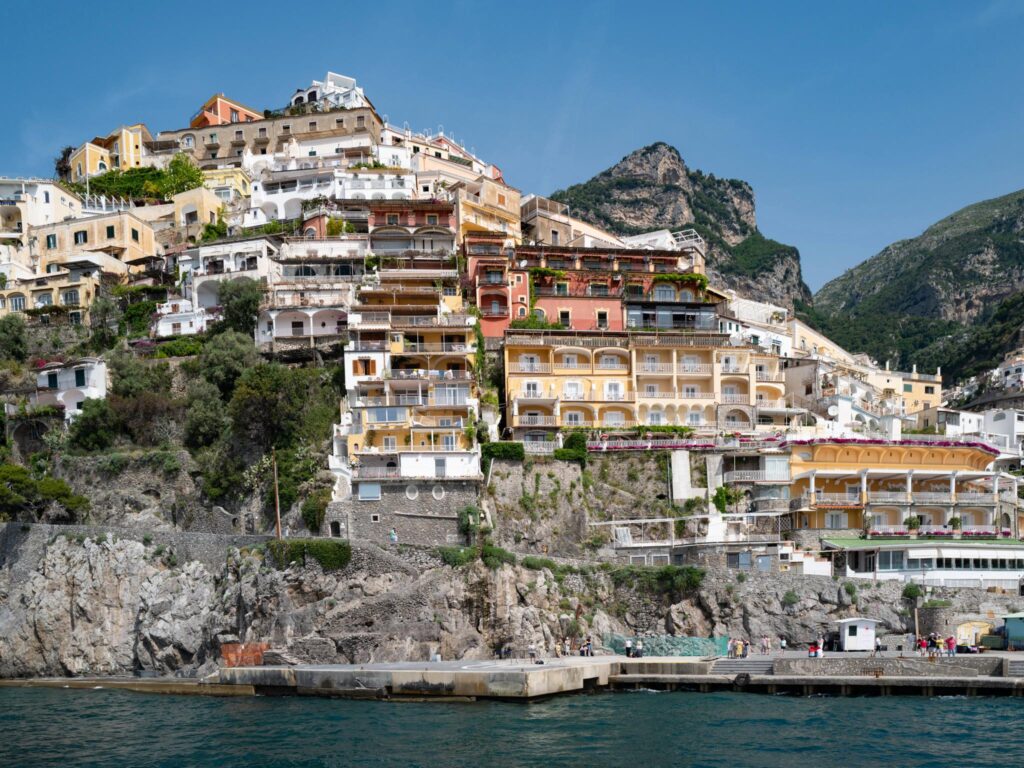
While Southern European cities are awash in brightly coloured buildings, running the gamut from pinks and reds through shades of yellow and orange, home owners here in Southern California, though enjoying a Mediterranean climate, generally eschew Mediterranean-coloured homes. To find buildings presenting the magic mix of all three ingredients, I rely on detective work, bicycle rides, and serendipity. I am the Inspector Clouseau of abstract photography. It’s a cause for great rejoicing when I stumble upon one, mes amis.

The other side of the bridge – Barrio Logan
At the northern end of the Coronado Bridge lies Barrio Logan, Spanish for Logan neighbourhood. It is a largely Hispanic district whose name derives from Logan Heights, a street laid in 1881. The street was named after congressman John A. Logan, who in 1871 had sponsored legislation to set aside land for a (never to be built) transcontinental railroad ending in San Diego. The land eventually became available for housing and retail use.

Barrio Logan is an art-centric district known for its murals, restaurants and coffee culture. Notable attractions include Northgate Mercado, a Mexican food market serving freshly-prepared ceviches (my favourite is the camaron y pulpo: shrimp and octopus), and the murals of Chicano Park.
The park encompasses pillars holding up parts of the Coronado Bridge, adorned with murals painted largely by the local community. It is a designated San Diego Historical Site and listed on the National Register of Historic places. The park resulted from grass-roots activism by local residents. They protested upon learning that the area, long designated for use as a park, was to be paved over and used a parking lot. They were successful – after a twelve day occupation by protesters, the city called off construction plans and agreed to develop the park.
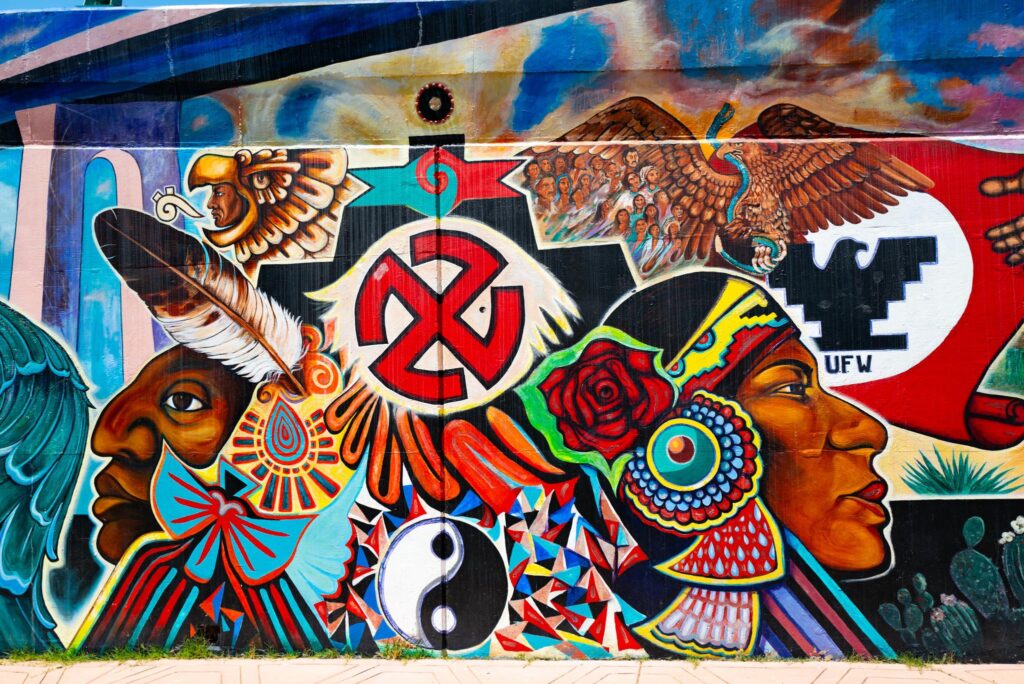



Abstract photography in Barrio Logan
Barrio Logan is where I made my discovery: a recently constructed apartment building whose designers’ extravagant use of colour reflects the importance of murals to the local culture, while offering a modern interpretation of the Mexican muralism art movement. I will present a collection of abstract interpretations of this marvellous structure and then show you the building itself. No skipping ahead!



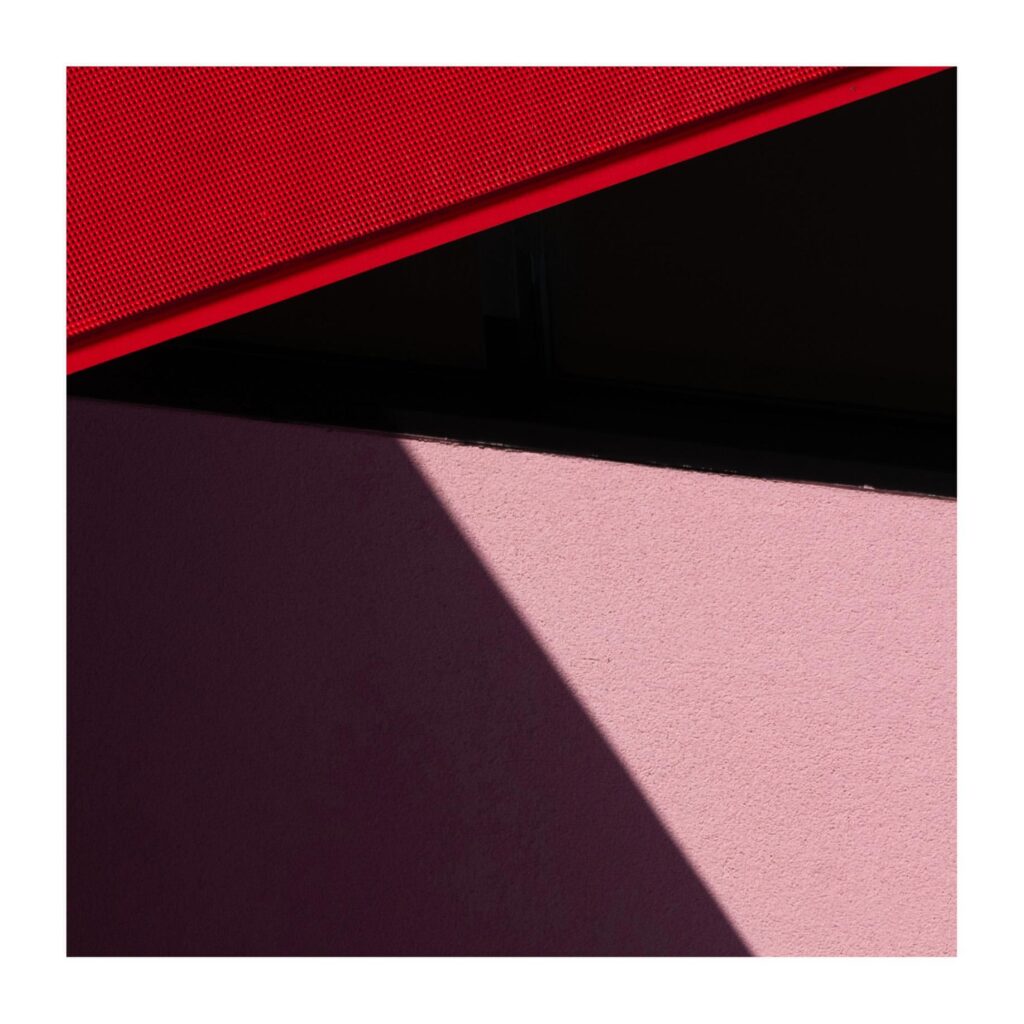
This first gallery exemplifies the subtle differences in shadow geometry resulting from variations in angle subtended by the sun and an observer with a camera. Each is composed of four geometric shapes, anchored by a red right-angle triangle poking the corner of the frame. While each can stand alone, the panel arrangement reveals a second-order, composite image: five for the price of four!
To my eyes, the next group conveys a futuristic impression: glimpses of a space-age city, where cars fly through the air, or of ultra-modern habitats on an alien planet. I was fortunate to visit when shadows were pronounced, dodging traffic as I adjusted my vantage point to align key architectural features optimally; a few cars blew their horns at me.



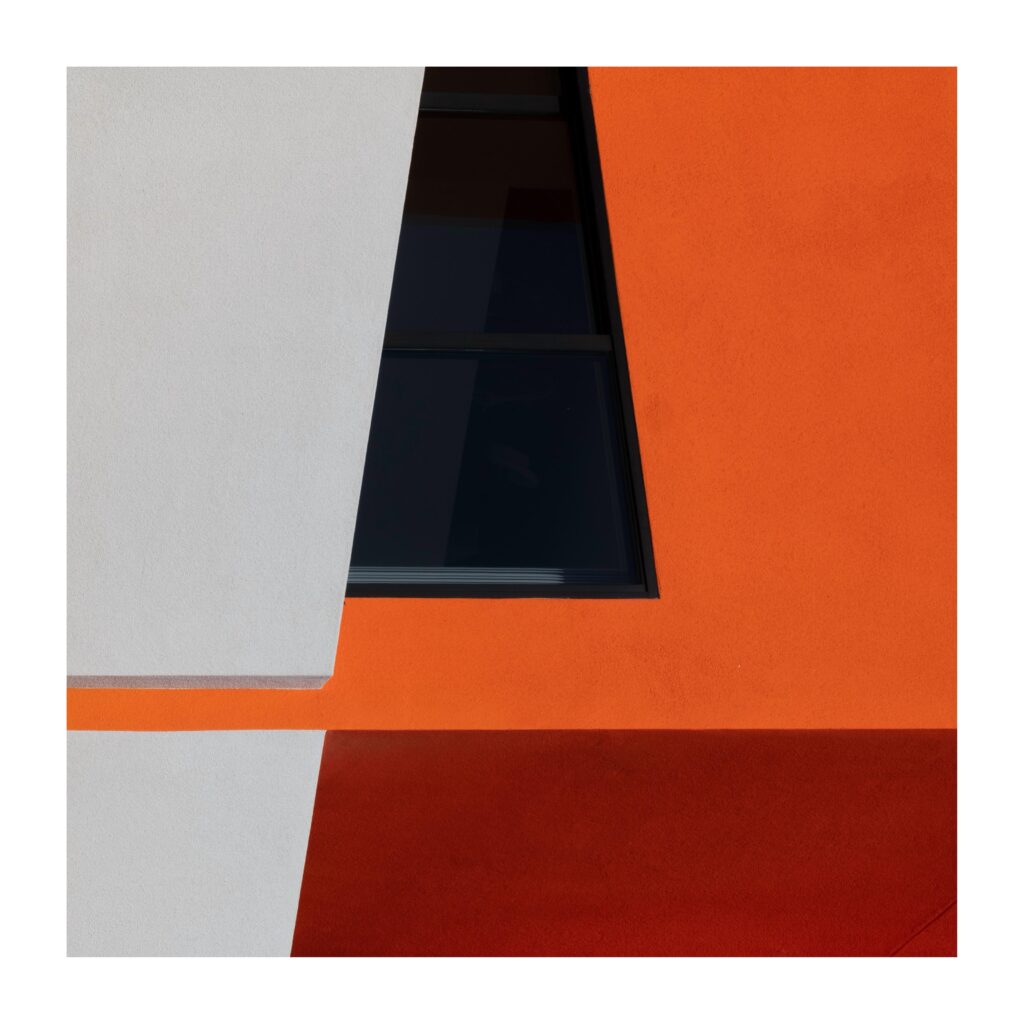
This third set of images incorporate blue sky as a geometric element. Remember that Mediterranean climate I mentioned? As you know, the depth and hue of the blue varies dramatically depending whether the camera is pointing towards or away from the sun. Although those parameters can be adjusted in post, these variations in shade were governed primarily by the viewpoint chosen as I photographed different walls of the building.



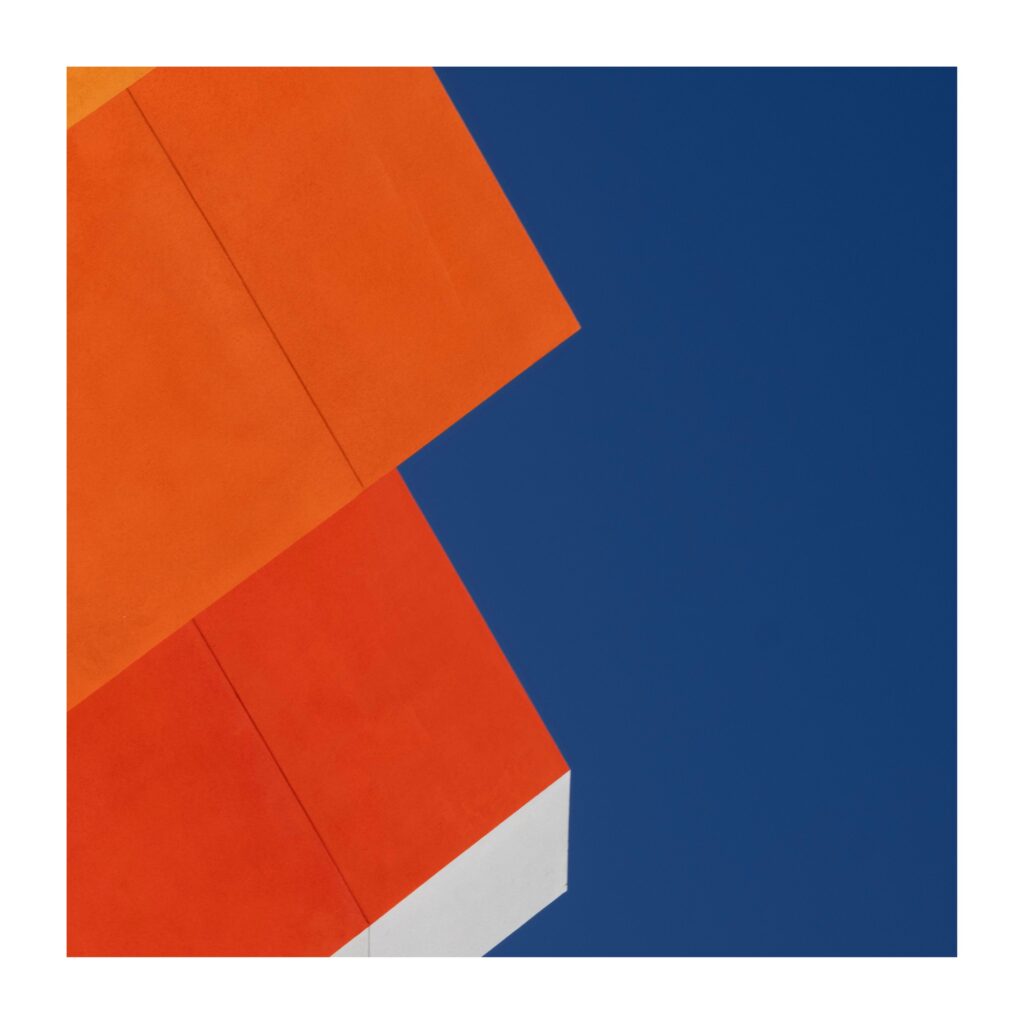
The final images exploit oases of colour in a desert of white wall, harnessing deep shadow where I could.

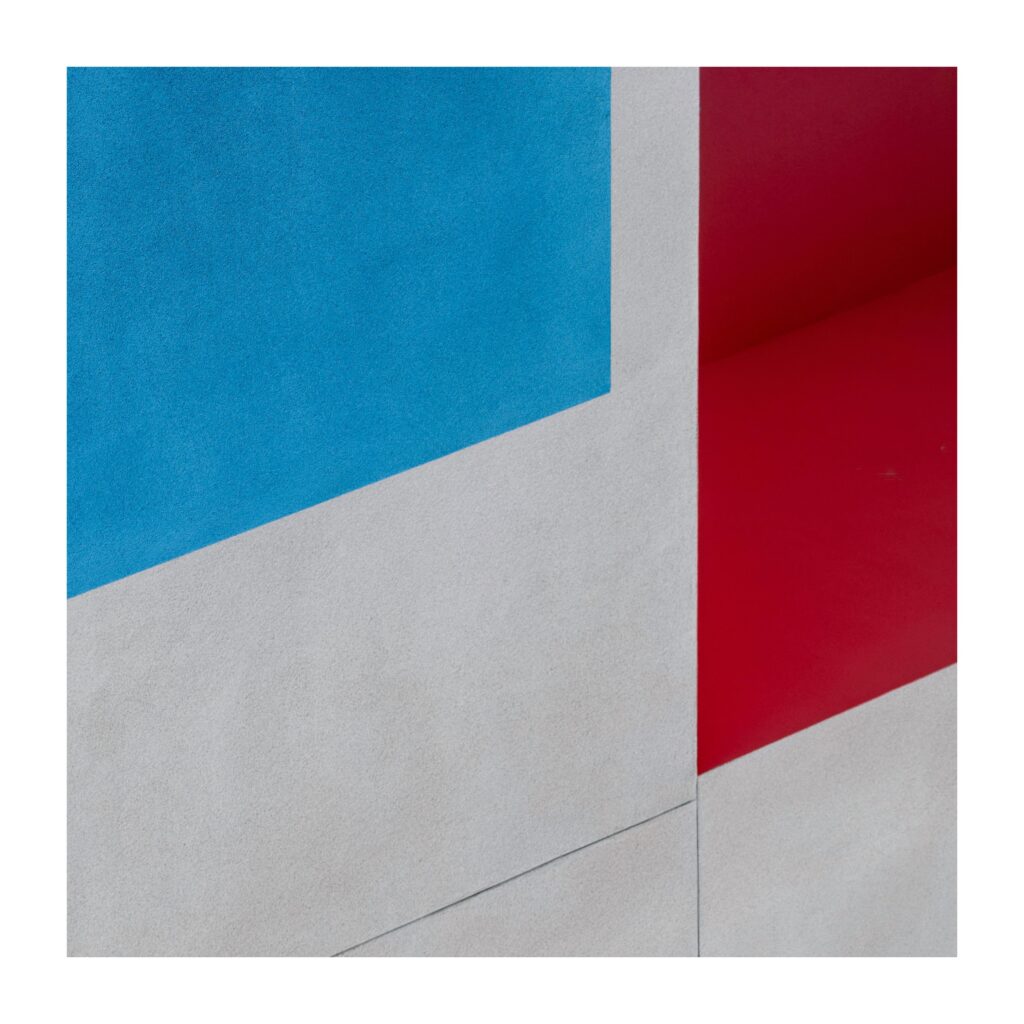
A one-building show
Periodically, I revisit the building, and my photographs of it, in the hope of mining further nuggets from its raw material. I have also experimented with compilations of the individual abstract images to create yet further images, as shown below. This is an idea for a banner I have submitted for consideration by the local cultural arts organization.

That cultural arts commission have also included the six individual images comprising the banner in an exhibition of work by new local artists at the C3 Gallery in Coronado. I told you I had hit the jackpot when discovering that building!
An auspicious address – 1776 National Avenue
I have classified these images as examples of abstract photography, but they fit into an even more specific niche within that niche: abstract-geometric or abstract-architectural photography. I have previously alluded to my obsessive tendencies when exploring a particular photographic genre; in devoting an entire article to abstract images of a single building, I believe I have reached new heights (or depths) of infatuation.
Do you really want to see what that building looks like? Do you need to see it to put the abstracted images into perspective? Since I promised to show it to you, here are two views from slightly different vantage points. Love it or hate it, it is unique. Will I find another building offering such a rich vein of opportunities for abstract photography. The search goes on!


The photographs were taken with a Leica SL2, fitted with either a Sigma 100-400 mm f/5.6-6.3 Contemporary zoom lens or a Leica 24-70 mm f/2.8 Elmarit zoom lens.
Do you have a photographic obsession? Is there a favourite building you enjoy photographing? What are your views on abstract photography? Please share your thoughts in the comments.
Read more from Keith James
Join the Macfilos subscriber mailing list
Our thrice-a-week email service has been polished up and improved. Why not subscribe, using the button below to add yourself to the mailing list? You will never miss a Macfilos post again. Emails are sent on Mondays, Wednesdays, and Fridays at 8 pm GMT. Macfilos is a non-commercial site and your address will be used only for communications from the editorial team. We will never sell or allow third parties to use the list. Furthermore, you can unsubscribe at any time simply by clicking a button on any email.


Hello Keith,
You have written another excellent article if I may say so.
I took nearly the same view of the houses on the cliff at Positano back in 1999. I actually drove along the cliff road, parked my hire car in perhaps the only car park in Positano and took photographs from the water’s edge. These types of images must appeal to both of us.
I particularly like the patterns and geometry of your images.
I wonder what you have got in store for us next time. I still remember your weathervanes article.
Chris
Hi Chris – thank you so much! That’s very kind of you. Apparently, Positano is the most photographed fishing village in the world! I traveled there by ferry from Sorrento and so had the benefit of some very nice views as we approached the beach. It is a sensational spot.
My next article will be very different – back from the abstract world to the real world. Mike and I are also cooking up something for posting down the road.
Thanks for your continued appreciation of that article on weathervanes – my very first for Macfilos! All the best, Keith
I seem to have mixed up my replies. The four color result had been around for over a century, as I recall, so I’d guess that to understand it one would have to be an expert on that topic, which I am not. However, I did write the following (unpublished) which has a good reference:
“ To draw a map, you color it so that countries with common borders
have different colors. The theorem shows that you need at most
four different colors. It was proved in 1976 by Kenneth Appel and
Wolfgang Haken of the University of Illinois; for a semi-popular
explanation, see Appel, Kenneth; Haken, Wolfgang (October 1977),
“Solution of the Four Color Map Problem”, Scientific American, 237
(4). The idea was to find a minimal collection of maps that could dis-
prove the conjecture (about 1,900 such) and then use a computer to
color them with only four colors, thus eliminating all the examples
where four colors might not work.”
And there’s where my expertise begins and ends 🙂
Thanks Kathy. It’s handy knowing we have a mathematician within the Macfilos community! 😉
Actually, Keith, I think we have at least one of everything in the Macfilos community. Lots of professors, lawyers, doctors, at least one Rabbi, a famous actor or two and a Hollywood film director! All we need now is a prince of the blood and we have a full hand.
Mike — That’s an amazingly high-powered group MACFILOS has assembled. It speaks to the quality of the site you’ve birthed.
Many thanks, Kathy. We may not have the largest readership in the Leica world, but I like to think we have the best group of people. Mike
Mike
I feel humbled. I was just a professional soldier who learnt how to march and how to polish my boots.
Chris
And, I feel compelled to add, a damn sight better photographer than a certain mathematician I can name 🙂
Glad to have brought it here.
It shows a topological property of the two dimensions space. Yes, actually it was “proved” by a computer, and no rational demonstration till now (mathematicians still are in the try). In fact it’s called conjecture rather than theorem due to that lack.
For me has always been fascinating.
I’m an engineer and never was taught or know about till rather recently.
Keith compositions brought me immediately to it
I suspect “conjecture” expresses the feeling of many. The software for the original ‘proof’ was found to have a flaw, as was the second try.
Fortunately we can enjoy the photography without fear!
No fear. Not about software flaw; just computers don’t give a prove. No mathematician can explain, or perhaps neither understand, the why. Thanks 😊
You may have seen Siegfried Hansen’s work (seigfried-hansen.de). He takes abstract photographs to another level. The Logan building is indeed a rich source that should keep giving you material for your style of photography.
Hi Farhiz, thanks so much for pointing me in the direction of Siegfried Hansen. I had not heard of him before. His work is fantastic. As you say, abstract photography taken to another level. Lots of great ideas for my next steps along this path. He even offers on-line coaching, which is very tempting. Thanks again! Keith
Your question on how your readers might feel about abstract photography made me think. But first, a bit of background. Before retirement, I was a mathematics professor; I spent the first half fo my career doing very abstract mathematics. And the second half attempting to give it human meaning.
I reacted to the photos in a similar way. I absolutely loved the photos at Chicano Park. The abstract photos — I suspect I don’t have the kind of mind or training to understand them. I didn’t cheat! But, when I saw the building, I went “Oh, wow! That’s great. I love that building!”
Putting the abstract together somehow made it work for me 🙂
The buildings are beautiful. The photographs are triangles and rectangles
Hi George, glad to hear you enjoyed seeing the building. Isn’t it great! Yes, the photos are a very simplified abstractions. I love triangles, diagonals and rectangles – especially brightly colored ones! Cheers, Keith
Not kidding about the theorem, Keith: a peculiar paradox beyond color abstraction; much cooler than Mondrian or Vasarely
Hi Kathy – thank for reading and commenting. I recognize that abstract art, let alone abstract photography is not to everyone’s taste. I happen to enjoy abstract images, and not being a painter it has been great realizing I can create them using photography. Most people are puzzled by them when they see them on display, and assume they are modern art paintings. I take that as an indication that I have succeeded in some way! I am very pleased to hear that you like the building too. I think it is destined to become a real landmark in Barrio Logan. Cheers, Keith
It may be an issue of taste, but I wonder …. there’s a book titled “How To look At Art”. For me, I suspect it’s a question of how to understand what I’m seeing.
After all, Piet Mondrian can’t be all wrong 🙂
No, he’s all right. And Vasarely makes you crazy 😜
And Keith’s works show a great taste also; just they bring to mind the theorem: in some manner the impossible task of expressing through shape and colors
Hi George, I did look into the four color theorem – thanks for bringing that to my attention! Reading the article certainly stretched my mathematics abilities to the limit. Fascinating though. I suspect Kathy knows it all backwards! I now feel a personal challenge coming on whereby I track down a four color abstract image which illustrates compliance with the theorem in a photographic context. Cheers, Keith
At the risk of being silly, I wonder what DALL-E2 would produce if asked to ‘construct’ a painting i the style of Vasarely 🙂
Great photos! As an architect, historian and photographer I really appreciate images that appreciate the geometries of building! You probably know all this, but this building, by architect developer Kate Meairs of “RED Architects,” is one of many by this firm that specializes in affordable “loft style” housing – you might also like the little hotel Abpòpa Hillcrest (Ted Smith, Hector Perez and Kate Meairs, 2019) on 3776 Fourth Avenue, another geometrical delight. The team comes from and teaches at Woodbury University School of Architecture. and employ students in developing programs, who then go off to build for themselves. I know about this firm, not because I live in San Diego (I’m a displaced Enlishman in New York) but because of the courses I teach, and my professional relationships. You might also look up the work of Teddy Cruz who works tirelessly to house settled immigrant populations in the city and region.
Hi Tony, thanks so much! I was thrilled to read your message. It is incredible that another Macfilos reader knows about the building! I had tried to track down the architectural and construction firms but with no success. I have just sent a note to the RED office and am hoping they will help me connect with Kate Meairs, who apparently no longer works at the firm. I will definitely check out the Abpopa building, which is close to several places I often visit. I will also follow up your recommendation to look up Teddy Cruz. Thanks again for all your help. Keith
You know the four colors theorem? It got me nuts for a long while. I think you’d like it; just computers found a solution !